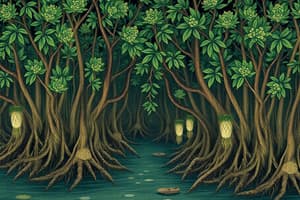Podcast
Questions and Answers
ما الغرض من أن تكون أوراق أشجار النخيل على شكل يسمح بسهولة مرور الرياح والأمطار؟
ما الغرض من أن تكون أوراق أشجار النخيل على شكل يسمح بسهولة مرور الرياح والأمطار؟
- تعزيز قدرة الاستفادة من ضوء الشمس
- زيادة كمية الأشعة فوق البنفسجية المستقبلة
- تجنب تجمع الماء على الأوراق
- الحماية من العوامل الجوية القاسية (correct)
ما هي وظيفة الجذور الضحلة لصالحاتُ الصحراء مثل الصبار؟
ما هي وظيفة الجذور الضحلة لصالحاتُ الصحراء مثل الصبار؟
- جمع الماء بسرعة (correct)
- تخزين المواد الغذائية
- تأمين الثبات التربوي
- تقليل فقدان الماء
ما التكيف المهم لأوراق نباتات نباتات المطريات؟
ما التكيف المهم لأوراق نباتات نباتات المطريات؟
- وجود أشواك للدفاع عن النبات
- أوراق مائية للتغذية
- أوراق كبيرة لجمع الشمس
- أوراق محكمة للحفاظ على الماء (correct)
ما هي وظيفة الأوراق الكبيرة لنباتات نباتات الماء مثل زنبق الماء؟
ما هي وظيفة الأوراق الكبيرة لنباتات نباتات الماء مثل زنبق الماء؟
كيف تساعد جذور صالحاتُ الصحراء في عدم فقدان الماء؟
كيف تساعد جذور صالحاتُ الصحراء في عدم فقدان الماء؟
لماذا قد تكون قدرة بعض أنواع أشجار النخيل على النمو السريع مهمة في بقائها؟
لماذا قد تكون قدرة بعض أنواع أشجار النخيل على النمو السريع مهمة في بقائها؟
ما دور النباتات في النظم البيئية؟
ما دور النباتات في النظم البيئية؟
ما هي أحد التكييفات التي يمكن أن تجدها في نباتات البيئات المائية؟
ما هي أحد التكييفات التي يمكن أن تجدها في نباتات البيئات المائية؟
ما هي خصائص النظم البيئية في المناطق الصحراوية؟
ما هي خصائص النظم البيئية في المناطق الصحراوية؟
ما هي أحد التكييفات التي تساعد نباتات البيئات المائية في التعامل مع ظروفها؟
ما هي أحد التكييفات التي تساعد نباتات البيئات المائية في التعامل مع ظروفها؟
هــل يتسبب توافر النجاسة في الماء في إضعاف النظام البيئي المائي؟
هــل يتسبب توافر النجاسة في الماء في إضعاف النظام البيئي المائي؟
كيف تُسهم التكييفات الخاصة للنباتات في بقاءها في بيئتها؟
كيف تُسهم التكييفات الخاصة للنباتات في بقاءها في بيئتها؟
Flashcards are hidden until you start studying
Study Notes
Plant Adaptations and Ecosystems
Plants have evolved various adaptations to survive in different environments. These adaptations help them find food and water, protect themselves from predators, and thrive in their habitats. Understanding these adaptations is crucial to appreciate the role of plants in ecosystems.
Desert Cacti
Desert cacti are adapted to survive in hot, dry environments with minimal rainfall. They have shallow root systems that allow them to collect water quickly before it evaporates. Additionally, their thick stems store water for future use, and the thick waxy cuticle on their stems prevents stored water from evaporating.
Palm Trees
Palm trees, found in tropical environments, have adaptations that allow them to access sunlight more efficiently. Their leaves are shaped in a way that wind and rain can pass through easily, reducing resistance during a tropical storm. Some palm trees also have the ability to grow quickly, which gives them a better chance of surviving in their environment.
Water Lilies
Water lilies, adapted to aquatic environments, have big leaves that float on the water surface to collect sunlight. Some water lilies also have thorns on the underside of their pads for protection from predators.
Rainforest Plants
Rainforest plants have adaptations to survive in wet environments. These adaptations include spongy tissue in stems and leaves, which helps plants move oxygen down to their roots, and floating, horizontal leaves that expose as much of the leaf surface as possible to the sun.
Aquatic Plants
Aquatic plants often have adaptations that help them survive in water, such as floating, horizontal leaves that expose as much of the leaf surface as possible to the sun. Some plants may also have emergent leaves that rest on the top of the water, allowing them to capture more sunlight for photosynthesis.
These are just a few examples of plant adaptations. Each plant species has unique adaptations that help it survive in its specific environment. These adaptations not only help individual plants survive but also contribute to the overall function and health of ecosystems.
Ecosystems
An ecosystem is a community of living and non-living things that interact with each other in a specific environment. Plants play a crucial role in ecosystems by providing food, shelter, and other resources for other organisms.
Desert Ecosystems
Desert ecosystems, where desert cacti and other plants thrive, are characterized by low precipitation and extreme temperatures. These ecosystems are home to a variety of wildlife, including reptiles, birds, and insects, which rely on desert plants for food and shelter.
Tropical Ecosystems
Tropical ecosystems, where palm trees and other plants grow, are characterized by high temperatures and rainfall. These ecosystems support a diverse array of plants and animals, from insects to large mammals.
Aquatic Ecosystems
Aquatic ecosystems, where water lilies and other plants live, support a variety of aquatic life, including fish, amphibians, and invertebrates. These ecosystems also provide essential services like water filtration and oxygen production.
Rainforest Ecosystems
Rainforest ecosystems, where rainforest plants like those mentioned above grow, are characterized by high precipitation and a diverse array of plants and animals. These ecosystems play a crucial role in global climate regulation and are home to many endemic species.
In conclusion, understanding plant adaptations and ecosystems is essential to appreciate the complex relationships between plants, animals, and their environments. Each plant species has unique adaptations that allow it to survive and contribute to the health of its ecosystem. By understanding these adaptations, we can better appreciate the vital role plants play in maintaining the balance of life on Earth.
Studying That Suits You
Use AI to generate personalized quizzes and flashcards to suit your learning preferences.




